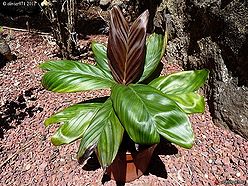Dypsis lanuginosa
| Dypsis (DIP-sis) lanuginosa (lah-noo-jih-NO-sûh) | |||||||
|---|---|---|---|---|---|---|---|
 Saint Denis, La Réunion Island. "Photo by Olivier Reilhes" | |||||||
| Scientific Classification | |||||||
| |||||||
| Synonyms | |||||||
|
| |||||||
| Native Continent | |||||||
|
| |||||||
| Morphology | |||||||
| |||||||
| Culture | |||||||
|
| |||||||
| Survivability index | |||||||
|
| |||||||
| Common names | |||||||
|
| |||||||
Contents
Habitat and Distribution
Endemic to Madagascar, Lower Mangoro. Humid Lowland Forests; alt. 300 m.Description
Trunks erect, clustered, less than 15 cm diam., clustering, erect, with conspicuous nodal rings, unarmed, occasionally branching near base. Leaves: leaf bases unarmed, yellowish, forming distinct crownshaft; blade pinnate [undivided], unarmed; plication reduplicate; segments lanceolate, evenly spaced, strongly ascending; apices acuminate. Inflorescences axillary below crown of leaves, paniculate, with 3 orders of branching; prophyll small; peduncular bracts caducous, tubular. Flowers unisexual, sessile, in triads of 1 pistillate flower flanked by 2 staminate flowers. Staminate flowers: sepals 3, imbricate, free; petals 3, briefly connate basally, valvate; stamens 6, free; anthers dorsifixed; pistillode present. Pistillate flowers: sepals 3, imbricate, free; petals 3, imbricate, free; staminodes 6, minute; pistil 1; ovules 1; stigmas 3. Fruits drupes, ellipsoid; exocarp yellow, smooth; mesocarp fleshy; endocarp thin, fibrous, terete in cross section. Seeds ovoid; endosperm homogeneous; embryo subbasal; eophyll 2-cleft; segments lanceolate. (Royal Botanic Gardens, Kew. Walter, K.S. and Gillett, H.J. (eds.) 1998)/Palmweb. Editing by edric.
Two Photographs of Specimens held at Paris Herbarium. Originally discovered in central eastern Madagascar in 1922, this species has been thought to be extinct for many years as the rainforests it was found in have long since disappeared. It is a small palm with a thin, cane-like trunk and several elongated, undivided and undulate leaves. (Royal Botanic Gardens, Kew. Walter, K.S. and Gillett, H.J. (eds.) 1998)/Palmweb.
Slender clustering undergrowth palm to 4 m tall. STEM 13 mm in diam., but said to reach 40 mm in diam., internodes 24-27 mm long, covered in dark brown caducous scales. LEAF with sheath c. 15 cm long, c. 2 cm in diam., distally very densely covered with thick red-brown tomentum and scales; auricles ill-defined; petiole absent; rachis 38-44 cm; blade entire bifid or with very small basal leaflets, otherwise entire-bifid, probably undulate and bullate; basal leaflets where present 7-11 x 0.4-1 cm, blade to 48 cm long, gradually widening from about 4 cm near the base to widest at the tip where 18 cm, the two lobes with a broad sinus, and shallowly to deeply lobed apically, adaxially with minute brown punctiform scales, abaxially minutely roughened and with irregular bands of caducous dark brown scales. INFLORESCENCE probably erect, branching to 2 orders; peduncle 40 cm long, about 4 mm wide at the base tapering to 3 mm in diam. distally, loosely shaggy hairy; prophyll inserted at least 3.5 cm above the base, 28 x 0.7 cm, with scattered dark and pale stellate and shaggy hairs; peduncular bract exceeding the prophyll by 9 cm; rachis 25 cm; rachillae numerous, probably at least 100, about 2-2.5 cm long, about 1 mm in diam., densely covered in pale brown shaggy hairs, triads about 1-1.5 mm apart, rachilla bracts rounded, about 0.5 mm high, obscured by hairs. Immature STAMINATE FLOWER buds about 0.5 mm in diam.; stamens 3, antepetalous. Other parts unknown. (J. Dransfield and H. Beentje. 1995)/Palmweb.
Represented by a single herbarium specimen collected in 1922. We know little about this undergrowth palmlet. Its most distinctive feature is the densely woolly inflorescence with a large number of rachillae. Superficially it resembles D. eriostachys, but the latter has staminate flowers with six rather than three stamens. The species name refers to the woolly hairs on the inflorescence. (J. Dransfield and H. Beentje. 1995)/Palmweb.
Although known from a single collection, this appears to be a distinctive species. The leaves are entire bifid or with two very small basal leaflets, and otherwise entire bifid, and there is no petiole. Drying of the specimen suggests that in the living state the leaf was probably beautifully undulate and bullate. The shaggyhairy inflorescence is similar to that of D. lantzeana but instead of having three antesepalous stamens, the three stamens are antepetalous. (J. Dransfield and H. Beentje. 1995)/Palmweb.
Culture
Cold Hardiness Zone: 10a
Comments and Curiosities
Conservation: Presumed extinct. Not collected for more than seventy years. The forests of the lower Mangoro River have now disappeared. (J. Dransfield and H. Beentje. 1995)
Originally discovered in central eastern Madagascar in 1922, this species has been though to be extinct for many years as the rainforests it was found in have long since disappeared. It is a small palm with a thin, cane-like trunk and several elongated, undivided and undulate leaves. (RPS.com)
- IMAGE GALLERY
External Links
References
Phonetic spelling of Latin names by edric.
Special thanks to Geoff Stein, (Palmbob) for his hundreds of photos.
Special thanks to Palmweb.org, Dr. John Dransfield, Dr. Bill Baker & team, for their volumes of information and photos.
Glossary of Palm Terms; Based on the glossary in Dransfield, J., N.W. Uhl, C.B. Asmussen-Lange, W.J. Baker, M.M. Harley & C.E. Lewis. 2008. Genera Palmarum - Evolution and Classification of the Palms. Royal Botanic Gardens, Kew. All images copyright of the artists and photographers (see images for credits).
Dransfield, J. & Beentje, H. 1995. The Palms of Madagascar. Royal Botanic Gardens, Kew and The International Palm Society.
Many Special Thanks to Ed Vaile for his long hours of tireless editing and numerous contributions.






